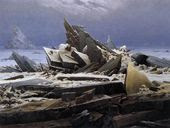
Still on the theme of Lough Derg, Laurence Flynn reproduces this image, in which Christ gives Saint Patrick his pastoral staff, and also shows him the purgatorial cave. The staff is known in Irish as the
Bacall Íosa or staff of Jesus.
The first French connection is that the image is contained in a manuscript held in the Bibliothèque Nationale in Paris. A second connection is provided by the French actor and writer Antonin Artaud (1896-1948). Troubled throughout his life by depression, drug addiction and mental instability, Artaud was a compelling actor and a visionary writer of plays, poems and essays. In the Paris of the 1920's he carved out a role in avant-garde theatrical productions, in cinema (playing the part of Jean-Paul Marat in Abel Gance's
Napoleon), and with the surrealist movement. In the following decade he would further develop his ideas on theatre, and produce his innovative adaptation on Shelley's verse drama
The Cenci. In the late 1930's Artaud travelled, to Mexico, Brussels and .... Ireland. Dr. Douglas Smith of University College Dublin presented a paper on Artaud's Irish visit at a conference held in Dublin in 2007. Dr Smith discussed the three reasons given by the French writer for his trip, and explained that only the first of these came from a shared intellectual experience. This was Artaud's search for the living roots of an ancient Western tradition, that of the Celts. His motivation here was in tune with the early twentieth-century feeling about Celtic culture, which influenced contemporaries such as J. M. Synge and Robert Flaherty (director of the film
Man of Aran). Artaud's other motives, while also linked to the culture of ancient Ireland, reveal his mental isolation and vulnerability. He believed that a decorated walking stick he had been given in Paris was the
Bacall Íosa, the staff of Saint Patrick himself, and he wanted to return it to Ireland. Lastly, Artaud wanted to find the "cup of Christ", the Holy Grail, which he was certain could be discovered in the National Museum in Dublin.
The full story of Artaud's stay in Ireland is related by Stephen Barber in his 1993 study
Antonin Artaud : blows and bombs. Arriving in Cobh on 14th August 1937, Artaud was deported from the same port as an "undesirable alien" on 29th September. He had stayed in the West, both on the island of Inis Mór and in the city of Galway. With little English and very little money, he left behind him a string of unpaid bills, and ended up in Dublin, where he slept rough until he was arrested for vagrancy. He was imprisoned for six days in Mountjoy prison before his deportation. The cane, the
Bacall Íosa, disappeared during his arrest. While in Dublin Artaud had visited both the National Museum and Saint Patrick's cathedral with the aim of returning it to the Irish.
This French connection to the Purgatory of Lough Derg is completed by a letter Artaud wrote from Galway to a friend in Paris, mentioning that he would like to extend his journey north, to Donegal, because of the county's connection to Patrick. It is likely that he had the Purgatory in mind.




